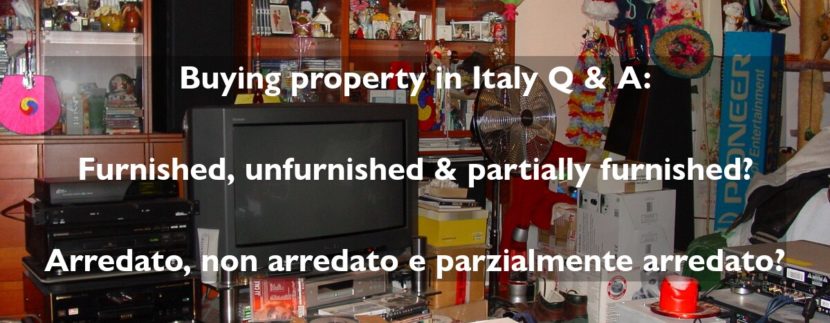What is the difference between furnished, unfurnished and partially furnished property?

By law, as stated in civil code article 1477, a property:
…must be handed over to the buyer in the state it was found at the time of the sale. Unless otherwise agreed by the parties [buyer and seller], the thing [property] must be delivered together with the accessories, pertinent things and fruits from the day of sale.
Often contracts will have a rote clause specifying that the seller is under the obligation to hand the property over free of people and things, which means the property will not be occupied by people nor contain personal effects and furniture. Some owners will take a very literal interpretation of free of things, ignoring the together with accessories part, and strip a home of everything, including fixtures and internal doors. Others will leave behind furniture and other objects without any commercial value, putting the onus on the buyer to pay to have the unwanted stuff hauled away.
The general recommendation is to clarify during negotiations what will be included beyond the bare walls and what won't. The common understanding needs to be explicitly documented in detail in writing. It would probably make sense to state that all fixtures present at the time of the viewing should remain except where specifically noted otherwise (personal photos mounted on the walls, etc). All installed systems (e.g. heating, cooling) should stay. If there are portable fans, air conditioning units, heaters, they will probably disappear unless the parties agree otherwise. Photos should be taken and shared between the parties to reinforce what has been written. A buyer can further protect themselves by making a walk-through shortly before the definitive payment… or at least saying they are going to be doing so as a preemptive warning to the seller that the buyer means business!
Historically sellers have taken their kitchen cabinet units with them as normally they are made of free-standing modular units and wall modules hung on hooks. A seller may want to leave the kitchen cabinets behind; again this point should be discussed and documented.
In the definitive deed transfer agreement drafted by the notaio, it can be documented what decisions have been made. A value will need to be assigned (not easy) and the furnishings will be subject to a 3% tax. In practice this is not commonly done. If the items actually have a cost for the buyer who has to haul them away, it should be noted the items have no commercial value (and the buyer should keep photos or other documentation to this effect should they ever be audited).
❖ ❖ ❖
The above is offered as general guidance without warranty; changes may have occurred since it was written. Do consult with appropriate qualified professionals regarding your specific situation before making any real estate purchase.
About the author

Sean Michael Carlos grew up in Rhode Island, USA. He studied in the US, UK and Germany before settling in Italy where he has lived for over twenty-five years, in three different regions.
Sean is a licensed real estate agent in Italy with over 10 years experience in the sector and would love to hear from you if you are looking to buy or sell property in Italy.




































